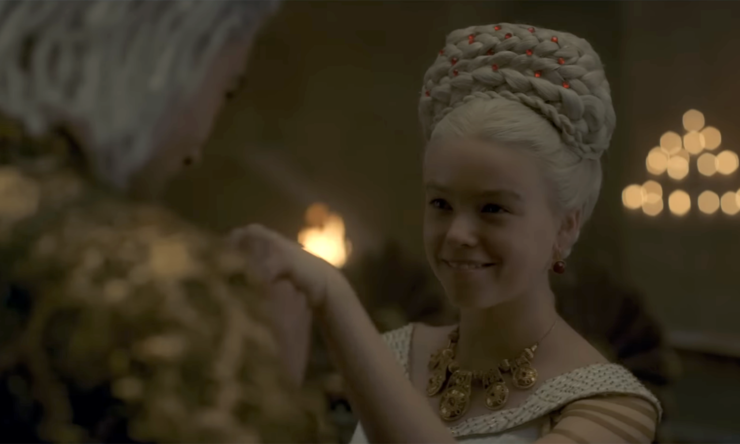Episode 5 of House of the Dragon featured the continued fallout and fractures from last week’s cascading sex scandals and attendant lies, culminating in the sort of tension-filled, rolling disaster wedding that became a hallmark of Game of Thrones, punctuated by the most white-knuckle formal dance ever put on television. The show continues to insert smart and nuanced twists into Martin’s original narrative, but stumbled a bit in its commitment to pushing back against the problematic tropes that its predecessor indulged in.
(Some spoilers for Game of Thrones and the novels below, for anyone who might be avoiding those.)
The Title
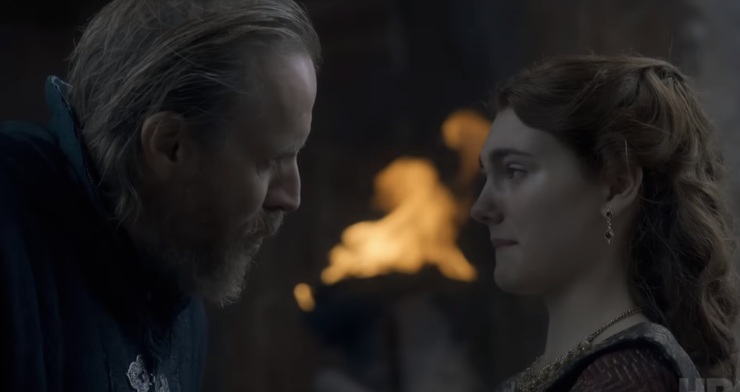
Episode 5 is entitled “We Light the Way”: the words of House Hightower, named for the literal high tower that sits in the center of Oldtown’s deep harbor. With the High Tower serving as a beacon for ships entering Westeros’ largest port (and, at this point in history, its largest city)—the House words are a reminder of the family’s importance as patrons of Westerosi culture. They preside over not only the trade routes of the continent’s Western coast, but the sciences and religion of the Seven Kingdoms as well. Both the Citadel (where the Maesters are headquartered and trained) and the Starry Sept (which, prior to the construction of the Great Sept of Baelor in King’s Landing—between twenty and forty years after the events of House of the Dragon—was the center of the Faith of the Seven in Westeros), are located in Oldtown. While the Hightowers do not literally control either institution, they are patrons of both and many second sons of the House join and rise to lofty positions in both organizations.
Thus, the Hightowers, despite being bannermen to the Tyrells (and the Gardners before them), are among the most politically influential Houses in Westeros, brimming with soft power. Showrunner Miguel Sapochnik has said in interviews that Otto Hightower (Rhys Ifans) “sees the danger in everything and, even though his intentions are good, he has persuaded himself that there is nothing but good intention behind his actions.” Otto features less in this episode than in any other, but his talk with Queen Alicent (Emily Carey) sets in motion the spiraling tragedy that ends with the gulf between Rhaenyra and Alicent wider and more dire than ever. By the time Alicent shows up to her step-daughter’s wedding dressed in a deep green—which, we are told, is indicative of the Hightowers at war—the fuse has been lit and the tribulations to come are all but certain.
Queer Westeros
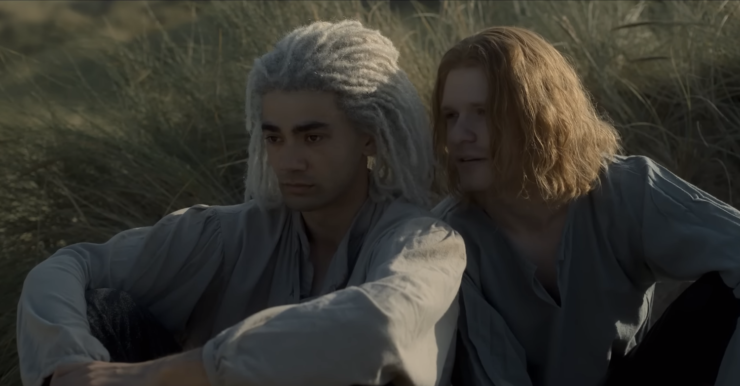
Laenor Velaryon (who has been played by both Matthew Carver and Theo Nate this season) and Joffrey Lonmouth (Solly McLeod) are far from the first queer characters to be depicted in Westeros, but both the books and the show have occasionally struggled when it comes to telling those characters’ stories in a thoughtful or consistent way.
Looking back at the nearly thirty years since Martin began writing, one can track a marked improvement in his approach to queer representation. In 1996’s A Game of Thrones, representation was limited, more or less, to the effeminate, frivolous Renly Baratheon, and a single line about a minor character, Lyn Corbray. By 2018’s Fire & Blood, Martin seems to fairly regularly acknowledge numerous characters with a variety of sexual identities and Westeros is largely (though not certainly not completely) free from religious and cultural homophobia (oddly enough, the original show makes a bigger deal of sexual “deviancy” and its persecution by the extremist Sparrow faction of the Faith of the Seven than the books do).
Where homophobia and the oppression of queer people does exist in the Westeros of the novels, it features in the narrative most often in terms of anxieties about succession in the peerage. Taking lovers of the same gender seems to be less of a concern than refusing to sleep with and reproduce with one’s spouse—though, of course, marital infidelity is itself a grave matter among Westerosi nobility. Martin, via Archmaester Gyldayn, writes of the casual acceptance of queer nobility in Fire & Blood:
One objection was raised: Laenor Velaryon was now nineteen years of age yet had never shown any interest in women. Instead he surrounded himself with handsome squires of his own age and was said to prefer their company. But Grand Maester Mellos dismissed this concern out of hand. ‘What of it?’ he is supposed to have said. ‘I am not fond of fish, but when fish is served, I eat it.’ Thus was the match decided.
Which brings us to the death of Joffrey Lonmouth, the bloody culmination of Laenor and Rhaenyra’s wedding feast. The original Game of Thrones series made homophobia more commonplace in Westeros and also erased and simplified a number of queer characters: Cersei Lannister (Lena Heady), for example, is portrayed as bisexual in Martin’s books and is only ever portrayed as straight on the show. While House of the Dragon seems willing to engage more with queer representation, including the strong suggestion of a romantic link between Rhaenyra and Alicent, Joffrey’s murder in this episode seems to signal a worryingly cavalier approach to the deaths of queer characters. While I am of the firm belief that there can be useful, thoughtful, and necessary queer deaths in fiction, care and consideration must be poured into these stories and characters, lest they’re reduced to the lazy and all-too-familiar “bury your gays” trope that sullies queer representation and potentially does as much harm as leaving queer characters out of a story entirely.
Lonmouth’s death in Fire & Blood is also caused by Ser Criston (Fabien Frankel), who kills him during a tournament at Laenor and Rhaenyra’s wedding, but the motive in that version is far more opaque. After all, in the book, Gyldayn’s accounts suggest that Criston remains faithful to his oath, either in spite of being attracted to Rhaenyra or because he does not share her interest. To ground Ser Criston’s murderous outburst in both his growing paranoia over his oath-breaking coming to light and his despondency over Rhaenyra’s lack of interest in running away with him, Joffrey is reduced to a convenient flashpoint in the Kingsguard’s emotional journey. That certainly does not feel like a thoughtful handling of the show’s first (somewhat) out queer couple. Hopefully, Laenor and his story will be handled with a delicate intentionality going forward.
Unreliable Narrators: “The Bronze Bitch”
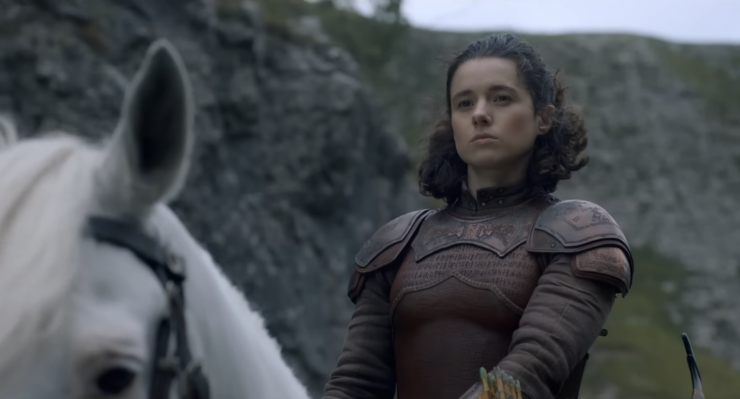
Prior to this episode, Daemon’s charmless sobriquet for Rhea Targaryen neé Royce (Rachel Redfort) was all we knew of her. In Martin’s books, she is the scion of House Royce of Runestone and a bannerman to the Arryns of the Vale. In the Game of Thrones era, Jon Arryn fosters Ned Stark (Sean Bean) and Robert Baratheon (Mark Addy) when they are children, eventually becoming Hand of the King under Robert until his poisoning death kicks off the events of the entire series.
Viserys’ first wife, Aemma, was herself an Arryn—the daughter of Rodrik Arryn and Daella Targaryen (one of the infamously mistreated daughters of King Jaehaerys). The Arryns and the Targaryens have a long history of peaceful alliance. That said, during Aegon’s conquest Sharra Arryn, Queen Regent of the Vale, initially opposed Aegon and his forces. When it became clear that the Vale couldn’t stand against the Targaryens, she proposed a marriage alliance between herself and the then-childless Aegon, provided he name her young son, Ronnel Arryn, as his heir. Aegon refused, but Sharra ultimately relented after Aegon’s martial sister, Visenya, rode Vhagar to threaten the Arryn capital at the Eyrie. Sharra gave up the crown of the Vale and Ronnel was given a ride on Vhagar as per his request…but also to demonstrate the powerlessness of any king against dragons. This tale was later romanticized as the young King giving up his crown in exchange for a ride on a dragon.
The Vale, being more or less unassailable by anything but sea (or dragonback), maintains a large and secure army. Marrying Daella to Rodrik Arryn helped secure this army, and marrying Daella’s nephew, Daemon, into her husband’s powerful banner house further was an attempt to ensure stronger links between them. The latter match was made by Jaehaerys’ wife, Good Queen Alysanne, who was famous for her matchmaking skills. Of course Daemon’s marriage to Rhea has turned out to be a singularly awful match, and their lack of children has further destabilized the Targaryen-Royce alliance.
Buy the Book
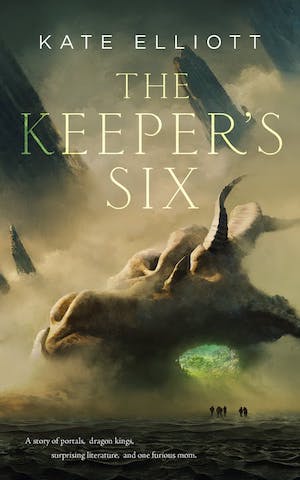

The Keeper’s Six
Of Lady Rhea’s death, Gyldayn says only that “there came a tragic mishap, of the sort that shapes the destiny of kingdoms […] Rhea Royce fell from her horse whilst hawking and cracked her skull. (Fire & Blood 374). He goes on to say that Daemon, upon hearing of his wife’s death, flew to Runestone for the funeral before trying to seize control of her lands and holdings, ultimately being rebuffed and banished from the Vale by Lady Jeyne Arryn, current head of the household.
By making Rhea’s death a murder at Daemon’s hands, the show is building Daemon into a far more sinister figure who is actively taking part in his plans for ascension. While the Daemon of Fire & Blood does many stupid, impulsive things in the name of rising higher, there is also a distinct sense that he tends to stumble into these situations. In the book, Rhea Royce’s death provided him with a pretext to attempt to take over Runestone but he does not set those events in motion. He (allegedly) sleeps with Rhaenyra, but Martin frames this as a part of his own sexual desire and grotesque fixation on sexual conquest, in contrast with the show’s portrayal of Daemon’s attempt to either secure the heir to Seven Kingdom’s as a wife or else discredit Rhaenyra by compromising her reputation and virginity and better position his own claim to the throne.
The show is also further complicating book-readers’ relationship with Archmaester Gyldayn. Last week, we got a definitive answer to the question of Rhaenyra’s sexual relationships with Daemon and Ser Criston Cole (Fabien Frankel) but that was clearing up Gyldayn’s own lack of answers and deference to his various, semi-reliable sources. Now, the show has given us an instance of Gyldayn’s definitive work being undermined by a secret history he could not have known about. Martin writes Gyldayn with an eye towards historical bias, the show is taking that a step further. It will be interesting as the show moves forward to see, much like the tale of Ronnel Arryn and the price of his crown, what stories get romanticized or forgotten.
Odds and Ends
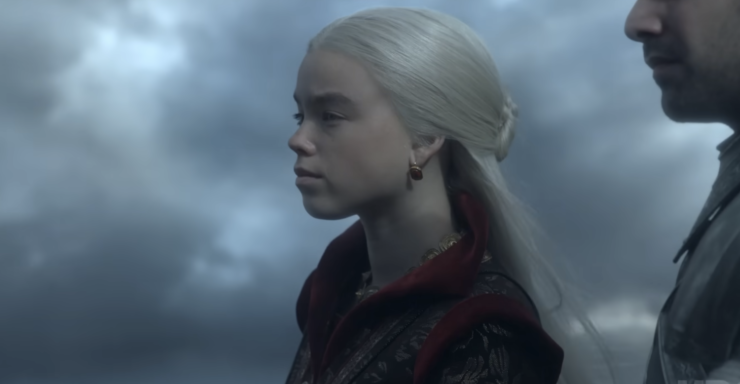
Halls of Nine
This episode gives us our first look at High Tide, the current seat of House Velaryon on the isle of Driftmark, and within it, Corlys Velaryon’s inner sanctum: the Hall of Nine. Though the Hall of Nine is an invention of the show, it is likely named for the Sea Snake’s nine great voyages, during which he traveled more extensively than any other seafarer in recorded history and traded for a vast array of treasures and artifacts from all over the world. His voyages include trips to Yi Ti and Leng (Martin’s rough equivalents to Yuan dynasty China), Asshai (a cursed city of dark sorcery at the far eastern reaches of the explored world), N’ghai and Mossovy (coastal kingdoms of Necromancers and demons on the far Northern coast of Essos), and Qarth (the decadent port city where Daenerys Targaryen spends most of season 2 of Game of Thrones). The show has yet to mention the nine voyages that Corlys Velaryon made on his vessel, The Sea Snake (from which his nom de guerre is derived), but the set dressers have filled the Halls of Nine with an embarrassment of plundered riches–from a giant gold and turquoise Nautilus shell to a marble bust disfigured by corals and barnacles. We even see him adjusting Craghas Drahar’s Ghiscari mask in this episode, adding another grim curio to his resplendent collection.
The Red Queen
We get a very brief series of shots of the Velaryon delegation sailing for King’s Landing, which includes Laenor riding his dragon, Seasmoke (whom we previously saw in episode 3), and Rhaenys riding her own strikingly vibrant dragon, Meleys—the Red Queen. Rhaenys is a dragonrider of great renown and skill. This is the fourth adult dragon we’ve seen (viewers might recall the opening episode’s claim that House Targaryen controls ten during the reign of Viserys I), and it’s an exciting addition. Combined with an awe-inspiring shot of Vhagar in the trailer for next week’s episode, it looks like House of the Dragon will start living up to its name.
The Hightower
As Alicent Hightower enters the wedding feast, Larys Strong remarks that the green dress she is wearing is a signal of her allegiance to the House she was born into, as green is the color of the flame at the top of the Hightower when the eponymous House calls their banners to war. In fact, in Martin’s novels, the flame at the top of the Hightower is a standard color and the House heraldry features a red and yellow flame on a white tower. Alicent dressing in green is a key image in Fire & Blood, and will likely be a part of next week’s episode, but the show is choosing to anchor her chromatic predilections by making them part of House Hightower’s bellicose legacy. It’s another instance in which the show is making use of its relatively spare source material to give its characters and its world the sort of depth worthy of Martin’s Song of Ice and Fire novels.
***
Hopefully, House of the Dragon can keep trending towards its gratifying reverence for the things that made Game of Thrones such an entertainingly vicious show and work to correct the previous show’s careless or lazy missteps into misogynistic, racist, and homophobic territory. Joffrey Lonmouth’s death was a sour and uncomfortable note in what was otherwise a dizzying and tense exploration of the complicated social dynamics of Westeros’ ruling family. Next week looks to be the first after a time jump that will introduce the older versions of Rhaenyra, Alicent, and several other characters, roughly ten years after the events of “We Light the Way.” Saying goodbye to Milly Alcock and Emily Carey, who have been uniformly excellent, will be no small thing, but if the first half of the season is any indication, what’s to come will have more highs than lows…and more dragons than not.
Tyler Dean is a professor of Victorian Gothic Literature. He holds a doctorate from the University of California Irvine and teaches at a handful of Southern California colleges. He is one half of the Lincoln & Welles podcast available on itunes or through your favorite podcatcher. His fantastical bestiary can be found on Facebook at @presumptivebestiary and his article “Exhuming M. Paul: Carmen Maria Machado and Creating Space for Pedagogical Discomfort” is forthcoming in Victorian Studies.










